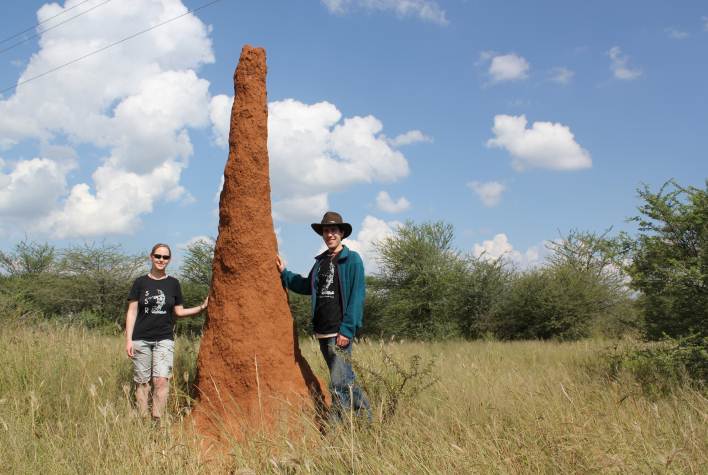
The TERMES robots can build themselves staircases to reach the next construction points, and they know how to add bricks that advance construction without blocking important paths.
A team of computer scientists and engineers at the Harvard School of Engineering and Applied Sciences (SEAS) and the Wyss Institute for Biologically Inspired Engineering at Harvard University has created an autonomous robotic construction crew. Inspired by the termite. Insects don’t have the capacity to reason, and yet some are capable of building complex structures without ant central leader/ organisation.

Harvard graduate student Kirstin Petersen and staff scientist Justin Werfel admire a termite mound in Namibia.
"On the plains of Namibia, millions of tiny termites are building a mound of soil—an 8-foot-tall "lung" for their underground nest. During a year of construction, many termites will live and die, wind and rain will erode the structure, and yet the colony's life-sustaining project will continue." said a team member, The system needs no supervisor, no eye in the sky, and no communication: just simple robots—any number of robots—that cooperate by modifying their environment.
"The key inspiration we took from termites is the idea that you can do something really complicated as a group, without a supervisor, and secondly that you can do it without everybody discussing explicitly what's going on, but just by modifying the environment," says principal investigator Radhika Nagpal said in a release.
“We co-designed robots and bricks in an effort to make the system as minimalist and reliable as possible,” paper co-author Kirstin Petersen said in the release. “Not only does this help to make the system more robust, it also greatly simplifies the amount of computing required of the onboard processor. The idea is not just to reduce the number of small-scale errors, but more so to detect and correct them before they propagate into errors that can be fatal to the entire system.”
These robots can perform all the necessary tasks—carrying blocks, climbing the structure, attaching the blocks, and so on—with only four simple types of sensors and three actuators.
No comments:
Be the First to Comment ↓